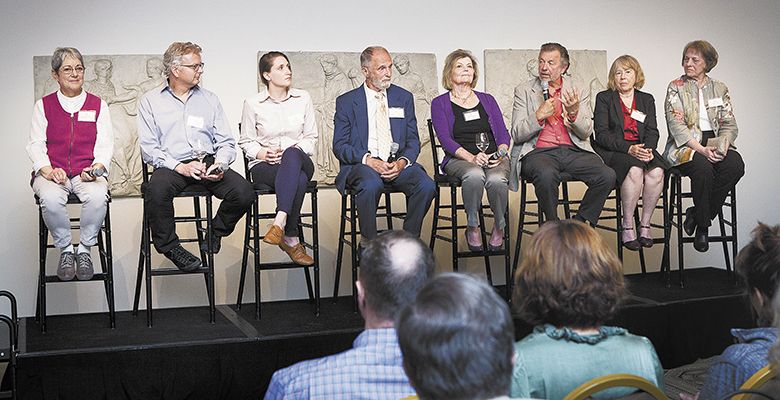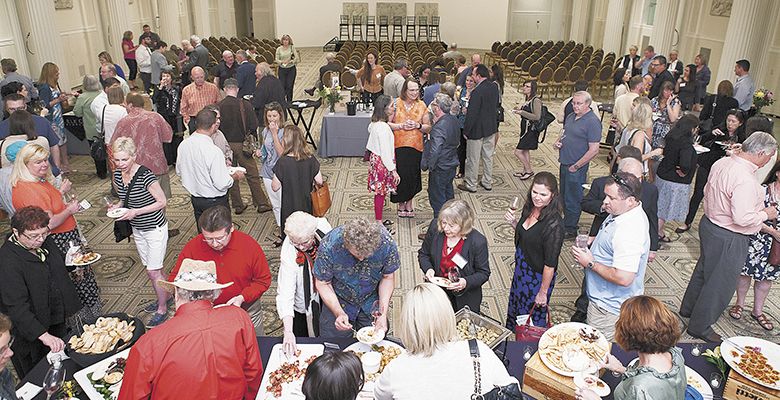Founding Family Affair
Willamette Valley Wineries Association event celebrates the early days
On May 3, the Willamette Valley Wineries Association celebrated the early days as it hosted an Oregon Wine Month event paying tribute to five of the region’s founding families. The $50 admittance attracted the anticipated 250 guests to the Portland Art Museum, where they were well treated. In addition to starter wines, the celebration concluded with a panoply of library offerings and recent releases from the founding wineries — the roster is as familiar as it is enduring.
On hand were Adelsheim, Ponzi Vineyards, Sokol Blosser, Elk Cove and The Eyrie Vineyards. All have morphed from winemaking in an under-utilized garage or shed to destination visitor centers showcasing both their respective wines and stories describing the making of them.
At the heart of these stories is Pinot Noir and the can-do persistence to create world-class wine despite more than a little advice countering it couldn’t be done.
Early sipping and mingling segued into a showing of the Oregon Public Broadcasting hour-long documentary, “Grapes of Place,” produced in 2011 by Nadine Jenling, who was present to introduce it and moderate the panel following.
Jenling began her project without having heard about, let alone consume, Pinot Noir. “At first, I figured I would be traveling the whole state for material. Then I realized the major story was close by in the Willamette Valley.” And with that admission, down came the lights and the big picture rolled.
Of course, the movie captured the small but determined steps planting the vines, growing the grapes and, in turn, learning the nature of terroir. But the story is as much about how these men people emerged from the campus turmoil of the latter 1960s to become farmers and stewards of the land.
The film pays tribute to Richard Sommer, founder of HillCrest Vineyard, who first planted several varietals, including Pinot Noir, in the Umpqua Valley in 1961. Another UC Davis contrarian, Charles Corey, advocated the important notion that certain Pinot Noir clones were better suited for specific places than others in a state where climate and growing conditions seem to vary by the mile.
The founders’ commentaries tended to portray themselves as escaping from conventional careers. David Lett, who founded The Eyrie Vineyards with his bride, gave up the lucrative potential of dentistry to pursue growing Pinot Noir on 40 acres in the northern Willamette Valley.
Referring to the effervescent energy at the beginning of Oregon’s modern wine industry, Diana Lett told the audience, “We’d say, ’There was Paris in the ’20s and McMinnville in the ’70s.’”
Susan Sokol Blosser added, “We all had the idea of doing something different. Wine seemed a cool thing to do, and although we had empathy for the environment, we invented sustainability farming just by doing things that suddenly made perfect sense.”
As an example, she recalled of the Salmon-Safe advocate who came up to Sokol-Blosser to sell her on the concept. “The salmon swim upstream, not uphill,” she said. “But your run-off goes downhill.” And that was that.
The exhausting work, the daytime jobs needed to subsidize the dream — Dick Ponzi happily taught school for years — as well as the guest workers camping in the living room or in outbuildings all went to support a kind of whimsical version of “Damn the torpedoes, full speed ahead!” in meeting challenges and crises associated with both commerce and nature. What kept the beat was collaboration.
Adelsheim winemaker Dave Paige told the museum gathering he always admired the annual retreat at Steamboat in Southern Oregon, where winemakers still meet to review with one another and learn. All through the growing year, informal get-togethers provided welcome relief and connection with the other vintners over the next hill. The spirit of collaboration ran deep and consistently since the first rows were planted.
Sokol Blosser offered, “We were liberal arts graduates. We knew how to work in teams. Imagine if we were all MBAs,” she trails off, leaving the audience to imagine amped up execs farming in Rolexes with stilettos on hand to overcome the competitors.
When in the mid-’70s and again in 1985 — a great vintage year — Parisian wine mavens discovered these Oregon winemakers, Pat Cambell of Elk Cove remembered thinking, “We weren’t just those hippie guys from up North.”
By 1987, upon the urging of his daughter, who interned at the Adelsheim property, Joseph Drouhin took little time to decide this part of Oregon could likely stride over millennia in much the way the vineyards of the Côte-d’Or had done — outlasting interloping armies, despots, weather and tourists.
Recollections maintain their merriment, but this was serious stuff. When equipment manufacturers arrived to introduce labor saving machinery, Ponzi notes, “The machine built to de-stem and crush the new fruit worked too well. We realized that our grapes needed gentler handling, even at the cost of some well-deserved efficiency.”
Early in her stewardship, Nancy Ponzi started raising cattle, goats and a victory garden. Biodiversity happened before anyone gave it a name.
In our celeb-centric, 15-minutes-of-fame culture, events like this can devolve into self-congratulation fests. What matters most remains this fact: When this writer was taking Driver’s Ed, there was no Oregon wine industry. Yes, there was Honeywood followed by HillCrest. And for the rest, no wine culture existed. A world guide to wine didn’t know where Oregon was, and no wine book spent one cent of ink on Oregon wine.
Today, bankers stock their cellars with Oregon wines grown on land their forebears wouldn’t finance and for which no business model existed. These men and women changed all that.
Where does it go from here, say, in another 50 years?
Elk Cove’s Joe Campbell said, “At first you think you’re building a winery for your children. But it’s our grandchildren who will enjoy the best of it,” the still-on-call physician says, “and we have eleven. We did our job.”
Ken Friedenreich is the wine editor for California Homes Magazine. He now lives in Portland while he works on his book “Decoding the Grape."














